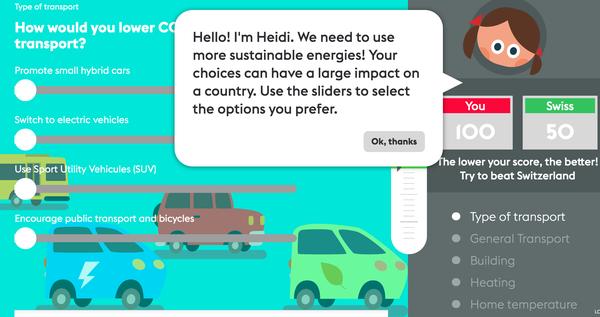A video game demonstrates how energy choices affect our carbon footpr

© 2017 EPFL
“Mission Possible” combines scientific rigor and good fun to help us understand the carbon impact of our personal energy choices. The video game has just been previewed at the energy-themed International Exhibition in Astana, Kazakhstan.
Can we reduce our CO2 emissions to half the 1990 level by 2030? This is the challenge Switzerland has set for itself and which was approved by the people in the recent referendum on the energy transition. It's a shared goal, but to achieve it we will each have to make a personal effort. To help us get there, researchers at EPFL's Energy Center have added scientific data from Swiss Energyscope, an information platform developed by several laboratories on campus, to an interactive video game about energy that was first presented at Umwelt Arena in Spreitenbach, Switzerland in 2014. In just a few minutes, the most Swiss of all heroines, Heidi, and her grandfather guide us along the road to energy redemption. Although we may think we’re doing our fair share to achieve the country’s energy targets, in reality we’re not.

“Switzerland is one of the worst offenders in Europe in terms of developing renewable energy – we're far behind the Scandinavian countries and Germany,” says François Vuille, director of development at the Energy Center. “We developed hydraulic power and then rested on our laurels.” The researcher has plenty of other examples that show our efforts are falling short of the mark. “Our buildings are energy sieves, and our cars are among the most fuel-guzzling in Europe, with a large number of high-powered SUVs that are used just as much to crawl through town as to climb mountain passes.”
The aim of “Mission Possible” is to make us stop and think about our own energy consumption and its carbon impact in Switzerland. How do you get around: public transport, sustainable transport, a hybrid or electric car, or a big SUV? Have you thought about properly insulating your home? As you guide your hero or heroine through the game, you have to make choices like these while also ensuring you don’t use too much electricity. You are then informed of the carbon impact of each choice. And to make things interesting, some options lead to a dead-end: “You can opt for nuclear power, for example, which is very good in terms of its carbon impact,” explains Vuille. “But if you do, you'll reach a point in the game where you hit a wall. Based on realistic scenarios, this can happen at any time, forcing players to rethink their choice of energy supply.” The point of the game is to meet or beat the targets in Switzerland's Energy Strategy 2050.
This interactive game is on display at the International Exhibition in Astana, in Switzerland's Flower Power pavilion, where visitors from Kazakhstan and further afield can learn about Switzerland from an ecological point of view. This can sometimes be eye-opening for those not yet attuned to these issues.
An educational version of the game is also being developed. It will be used in secondary schools to raise awareness in geography and economics classes.
The game is now available online at http://game.swisspavilion.org